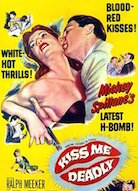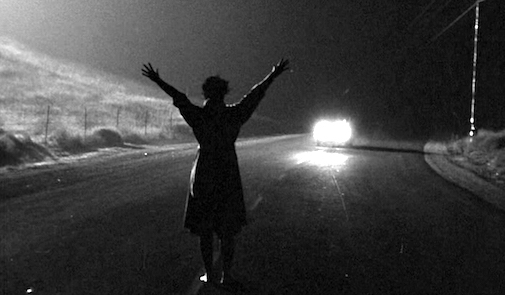It's Noirvember. Here's Bill Curran on a Robert Aldrich's neo-noir
 The world turned upside down, inside out. Film noir depends on following innate impulses to that most ultimate, unthinkable, irrational end: death. Noir explores that nasty thing called "human nature, revealing (and revelling in) the elemental urges that really make us tick. Noir unmasks the mechanics of this crazy world with some variation on a guy, a girl, and a gun. Upending sexual-patriarchal dynamics, leveling the tenants of justice and who is responsible for carrying it out, filming what we do in the shadows in the half-light: when you flip the script on taste and convention, you can learn a lot about how topsy-turvy this whole mess called Earth can be.
The world turned upside down, inside out. Film noir depends on following innate impulses to that most ultimate, unthinkable, irrational end: death. Noir explores that nasty thing called "human nature, revealing (and revelling in) the elemental urges that really make us tick. Noir unmasks the mechanics of this crazy world with some variation on a guy, a girl, and a gun. Upending sexual-patriarchal dynamics, leveling the tenants of justice and who is responsible for carrying it out, filming what we do in the shadows in the half-light: when you flip the script on taste and convention, you can learn a lot about how topsy-turvy this whole mess called Earth can be.
Kiss Me Deadly stews in and subverts these genre contradictions more brazenly than almost any other film noir before or since, perhaps because it is, in the end, about the dawn of the end of the world. Gonzo and sophisticated in equal measure, from the backward title scrawl to the A-bomb finale, this loose 1955 adaptation of the Mickey Spillane novel could be called the first neo-noir and what the Cahier du cinema crowd dubbed, "the thriller of tomorrow.”
 Cloris Leachman in her film debut!
Cloris Leachman in her film debut!
It possesses a knowing streak, that noir’s been done before so let’s blow it all to smithereens… or, to paraphrase a corrupt cop addressing private detective Mike Hammer...
Let him go to hell.”
Mike Hammer (Ralph Meeker), a contemptuous divorce dick with an unpredictable tender side (he calls a Caruso record “lovely” without a hint of irony), is a wily Dante cruising around the City of Angels trying to muster up leads on a deadly encounter with a midnight hitchhiker in the film’s en medias res opening salvo. Less hard-boiled than sun-baked, Hammer is clearly a talented investigator as he’s placed always two steps ahead of the audience. Yet, just as clearly, he lacks ambition and good ole’ common sense. He’s aided in large part by his secretary-cum-partner-cum-quasi-girlfriend Velda and also by his chutzpah. Like most noir protagonists, he just can’t help himself when he knows he’s heading for a jam (or the gallows). But what exactly is he chasing down?
His “great whatsit” case, to find out what madhouse escapee Christina Bailey (Cloris Leachman) knew, leads nowhere and everywhere. For much of the film, Hammer learns very little about his mysterious highway encounter, listening mostly to death threats or reports of death threats as he passes through the noir-typical network of lowlifes and down-and-outers. It’s well into the second hour of Kiss Me Deadly before Hammer makes a real investigative breakthrough (it involves a poem). Even when the pieces fall into place, they hold power only through suggestion, by what “a random jumble of letters” implies. What happens for much of the film, though, is a whirlwind driving tour of Los Angeles; Hammer passes through cabarets, auto shops, stately mansions and pools, apartments both swank (Hammer’s) and dingy (everyone else’s), a solitary beach house that turns out to be a terrifying ground zero of sorts.

Filmmaker and critic Thom Andersen, in his exhaustive documentary Los Angeles Plays Itself, makes a persuasive case for Kiss Me Deadly as a seminal and ideal Los Angeles movie, as evidenced by Aldrich’s use of real, untouched locations and a fidelity to the city’s geography. (Aldrich not only avoids rear projection driving shots, he makes pains to show Hammer actually driving and parking his car all over town.) If the case leads to a shocking annihilation event—less a conclusion than a horrifying question mark—the film itself evokes, with a keen attention to realism, how people in every pocket of the city, on every back alley and boulevard, create and then cannot escape the grip of this doom.
Working off an acidic script from A.I. Bezzerides (On Dangerous Ground, Track of the Cat) and guiding Ralph Meeker to a great, succinct performance as Hammer, Robert Aldrich directs Kiss Me Deadly with a stead, supple hand, making the city-wide search and its revelations all the more insidious. A grand guignol maverick now famous for Whatever Happened to Baby Jane? and The Dirty Dozen, Aldrich is underrated for the lithe command he brought to the hot-to-the-touch material he was so often drawn to.
In Kiss Me Deadly, point-of-view camera and narration is used to subtly expressive effect: note Hammer’s visit to the Carl Evello estate and his first meeting with Christina’s roommate Lily in a fleabag hotel. During Hammer’s interviews of some Los Angeles denizens (the boxing coach, the failing tenor), Aldrich keeps our dick on the level with these average Joes by photographing each scene in elegantly but never ostentatiously mounted single takes. There is little threat, as both parties hold little power and pull, so Aldrich makes them equals in the frame. When faced with more lethal adversaries (the cop Lt. Pat Murphy, the mobster Evello), Aldrich, through variations in blocking and camera angle, will position Hammer as always looking up or precariously down to these men. Hammer can’t get a leg up, let alone understand what’s really going on in his own nutty plot.

It is this formal control that gives Kiss Me Deadly its unexpected edge. It marches us, with the no-nonsense aplomb of its anti-hero, straight down to its ocean-side apocalypse. Hammer—and the film noir, Hollywood, America, the world in the nuclear age—should have followed the aphorism Hammer himself spouts in the first few minutes of the film:
What you don’t know can’t hurt you.”